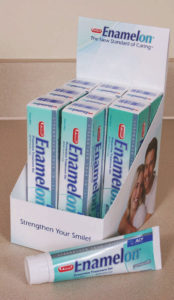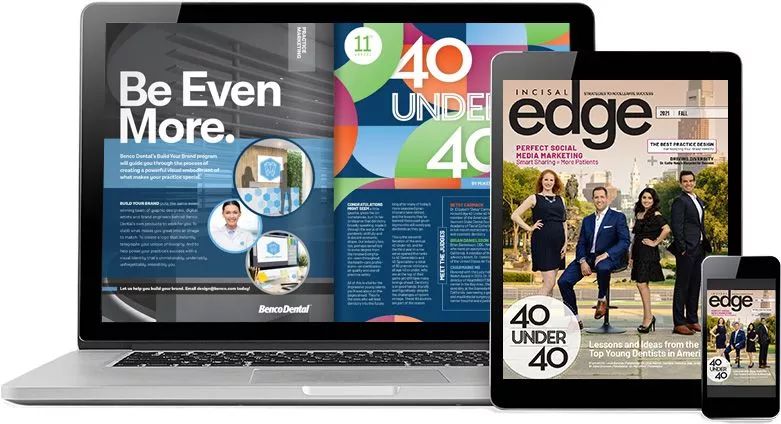BY JAMES DIMARINO, DMD
“YOU HAVE GOT TO BE KIDDING ME,”
is what my co-worker would have shouted if she was told one day she would be working in the dental industry, considering her poor oral health background. She grew up in a family where a visit to the dentist meant she was in pain. Either a filling (sheepishly admitting to nothing short of a MOD) or a tooth pulled. Her family did not have dental insurance and her father, a heavy smoker, had dentures at an early age. A dental hygienist didn’t exist in her world until out of college and on her own. As for myself, I am all about dental or medical. I come from a family of physicians; my wife is a dental hygienist. After years in clinical, I now work for a dental manufacturer and immerse myself in other dental professionals’ places of work.
My co-worker’s story follows with her first dental office pick that was based on her employer’s insurance, and verification of her good choice of picking a dentist was due to the office having satellite radio. Yes, satellite radio; forget the offices’ qualifications or services offered! Already
anxious and out of her element, she would never ask any questions, let alone offer more than a head nod. Was she a good patient? Maybe. Was she a compliant patient? Probably not. Inside, she was longing for someone to tell her something. “Are my teeth okay? Do I need braces? Can I get whiter teeth? My teeth sometimes get sensitive; help!” She felt if she mentioned any of these topics it may mean more buzzing of the drill. She didn’t know about prevention or developing healthy dental behaviors. She lacked proper knowledge on brushing her teeth and flossing was a rarity.
The first assessments of health literacy among US adults found that a majority have difficulty using health information with accuracy and consistency. These findings are especially relevant for chronic diseases such as oral disease, which require continual self-care and ongoing professional interactions.1 I started to think about the diverse backgrounds from which our patients come. Today, oral health prevention education has increased in exposure, but there are still areas or pockets of populations that miss the messaging. While you immediately think of undeserved, rural and lower income populations, they also may be in your office daily. The good news is that you are the key opinion leader when it comes to your patient’s oral health and you may have that captive amateur in your chair. Patients tend not to speak about sensitivity, because they may fear that the solution will result in a major financial investment. However, they will have no problem talking about it to their family and friends, and again once a resolution has been found. Based on my co-worker’s previous non-dental life, I offer up some ideas for open discussion.
- The reception area: Yes, your patients love catching up on all of the celebrity news, lifestyle and health magazines that are offered. It’s a guilty, personal pleasure that they do enjoy while taking their mind off why they may be there in the first place. Additionally, they also love the patient pamphlets; they may not take them, but they do read them to see if they can identify themselves with the issues. Please help them talk about what they read. Ask them if they saw them or had interest in anything. Patients are often reluctant to admit they don’t understand something about their health.
- When offering items for purchase: Whether you display them in the reception area or on the counter of an operatory, display signage, so your patients know they are for sale and list pricing. A consumer fear is selecting a product and then finding out at checkout it is $55.00 when she was thinking $25.00. This creates a negative experience and they may buy it, but only the one time. As a secondary reinforcement, telling the patient they are for purchase is a great conversation starter to explain the products’ benefits. This may help the patient feel comfortable communicating that they too may have the same or similar problems.
- Tell a story: Most patients understand HIPAA and confidentially issues, but anonymously hearing about someone else’s issues and how it was solved is very encouraging to your patient. Covering general oral care magnifies the effect. We use terminology such as patient compliance, but what we really want is patient adherence. This is a good way of cultivating the patient-clinician relationship with education through collaboration.
- Talk about your recent seminar experiences or trade show trips: Patients are interested in how you keep up with your profession. If you do volunteer work, show photos from the events! It’s okay to share something relevant about your business. Your
passion sells!

To encourage discussion at the front desk, Premier offers a point-of-sale display with the case of gel and provides an opportunity for patient engagement with pamphlets to encourage productive conversation. Patients forget up to 80% of what physicians tell them as soon as they leave the office. Nearly 50% of what they do remember is incorrect. Premier also offers a Treatment Pad with tear-off sheets so you can work together with your patient, ensuring that your instructions will be understood and available for reference once they begin the treatment at home.
As dental professionals, you are the most qualified to assess the oral health of your patients. There is a mass of noise and mixed-messaging that the patient is exposed to everyday through various media influences. Help steer them back to you as the go-to for oral health.



